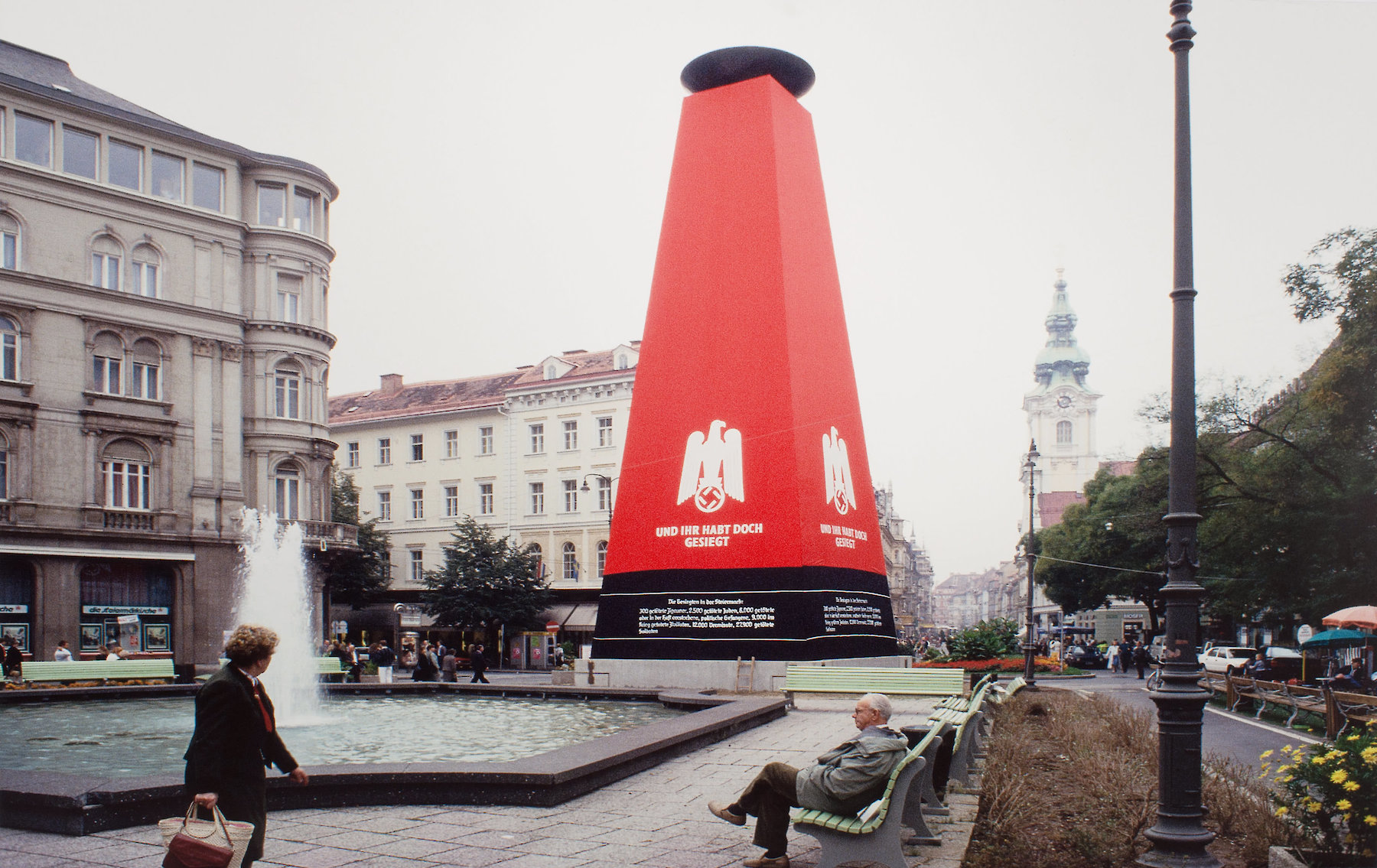Richard Kriesche: Marienlift Elevator (Documentary of the art installation) Gernot Rath, 2003 – 2007
A Victory Mark Decreed by the Emperor
The Marian column was part of propaganda that celebrated the victory over the Ottomans as a triumph of Christianity over Islam. With the introduction of a Marian holiday Graz wanted to seek protection from Ottoman attacks. Yet Emperor Leopold I recommended to erect a column following the Viennese model. According to the design of master-builder Domenico Sciassia, it was inaugurated on the Karmeliterplatz in Graz in 1670. In 1796, it was relocated to Jakomini Square. When the Marian Column was relocated to its present location at Eisernes Tor in 1928, it was renamed Türkensäule (Turkish Column) and the Ottoman threat was once again recalled.
Film (clip), 2:00 min
Lender: ORF Steiermark (ORF Styria)
ORF Steiermark (ORF Styria)
Madonna on the Crescent Moon
The Baroque, gold-plated statue of the Virgin Mary of the Marian Column in Graz was consecrated to the “Immaculate Conception of Mary” in 1670 and erected on a Corinthian bronze column. The theme of the “Madonna on the Crescent Moon”, or also “Madonna on a Crown of Stars” goes back to the Revelation of John. The twelve stars in the halo of Mary represent the twelve tribes of Israel. According to John, the moon on which Mary stands symbolizes the defeated evil in the apocalyptic battle. This type of representation of Mary has been very popular since the 15th century.
Victory over the Enemies of the Catholic Religion
In the symbolism of the Catholic Church and its secular representatives, the evil was equated with the Ottomans and the Protestants. Who the Mother of God was to protect from or who embodied the evil against, corresponded to the narrative of the rulers.
The Marian Column was commissioned by the Hapsburg rulers. With this they ostentatiously recalled the victory over the Ottoman armies in the Battle of Mogersdorf in Burgenland in 1664. And in this way, they anchored the religiously exaggerated interpretation of this event in the collective memory.
Triumph of the Bourgeosie in Graz
The Marian Column was moved from Karmeliterplatz to Jakominiplatz in 1796. The district’s founder, Andreas Edler von Jakomini, was keen to upgrade the Vorstadt (suburb) he had founded. The Marian Column became the landmark of the emerging bourgeoisie.
At its inauguration, the memory of the enemy image of the “Turks” was once again invoked —accentuated by the idea that the column shaft had been cast from cannon balls. The new enemy image of the French and the “danger of the French” were also referred to. In the 19th century, the Marian Column in Graz was also given the nickname Column of Victory.
German National Commemorative Culture
In the interwar period and by the “Corporative State” dictatorship a new kind of propaganda was practiced regarding the “Ottoman Wars” and the enemy image of the “Turks”. Due to traffic problems, the Jakominiplatz was redesigned in 1927. The “Verein Heimatschutz” (Association for the Protection of Homeland) worked to ensure that the Marian Column remained in a clearly visible place in the city centre and was renamed “Türkensäule” (Column of the Turks). Since 1928, the Marian Column has stood on the square at the Eisernes Tor.
This renewed relocation caused great uproar—rumours circulated that a war treasure from the time of the “Ottoman Wars” was hidden in the column. In 1927, Graz Municipal Council member Uhrner climbed the empty column in front of the large crowd of spectators after the statue of the Virgin Mary had been removed and affirmed that the view was “delightful”.
National Socialist Symbol of Victory
The central location and the symbolic charge of the Marian Column were also taken up by National Socialist propaganda. On 25 July 1938, a few months after the “Anschluss”, Austria’s annexation by National Socialist Germany, the Marian Column was clad monumentally in a grandly staged “commemoration of the dead”. The 20 metres tall obelisk framed with red flag fabric and National Socialist emblems was the culmination of the propaganda show in Graz.
As part of the spectacle, the city was awarded an “honorary title”: In gratitude for persistent National Socialist activity before the “Anschluss” (annexation of Austria), in particular the attempted coup in 1934, Graz was henceforth granted the title of “City of the Popular Uprising”.

Art as Memento
When the artist Hans Haacke reconstructed this huge “monument of victory” over the Marian Column again in 1988 and reinterpreted it as a memento, an arson attack with radical right-wing background took place. The Marian figure was severely damaged and could only be erected again after extensive restoration in 1990.
A Symbol of Democracy
The Marian Column underwent its last reinterpretation in 2003, the year when Graz was the European Capital of Culture. Media artist Richard Kriesche installed the “Marienlift” elevator, with which a new perspective on the city and the monument could be taken. Kriesche understood the glass elevator as a symbol for an egalitarian, democratic society: With its help, the citizens, every woman and every man, can move up and stand at eye level with the sacred figure. They can form their own opinion apart from the worldly and religious interpretations. Through the democratic elevation, there are no more rulers who stand above the people.